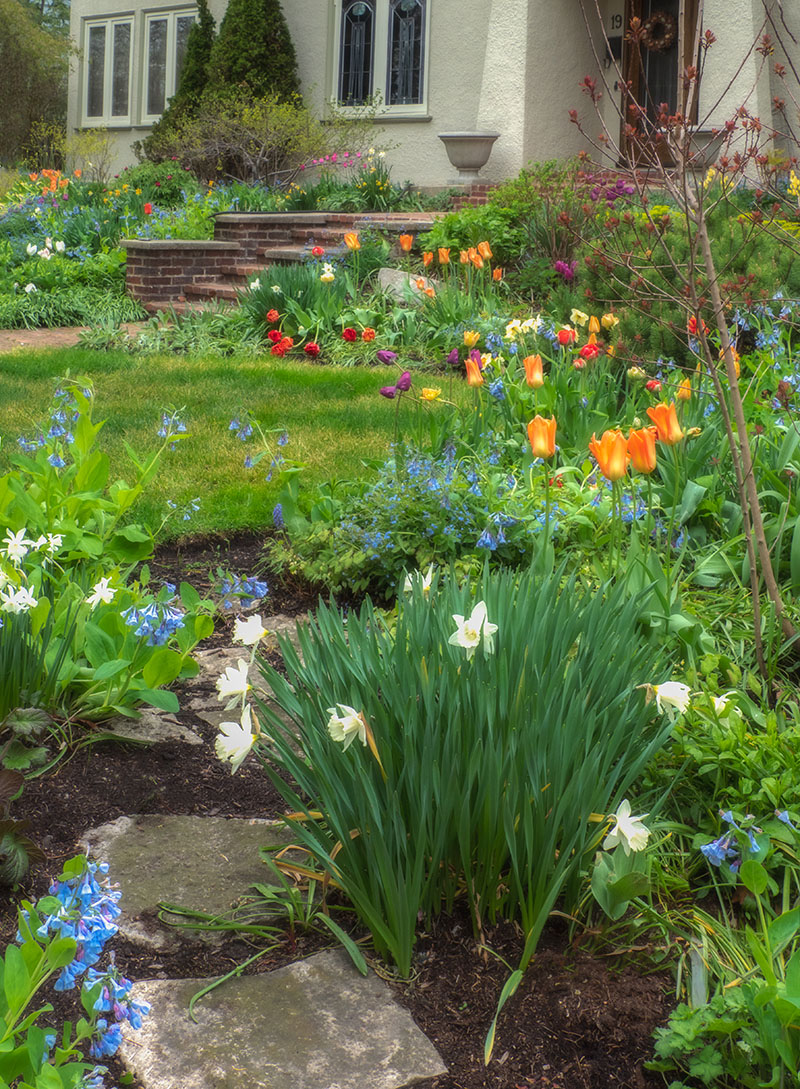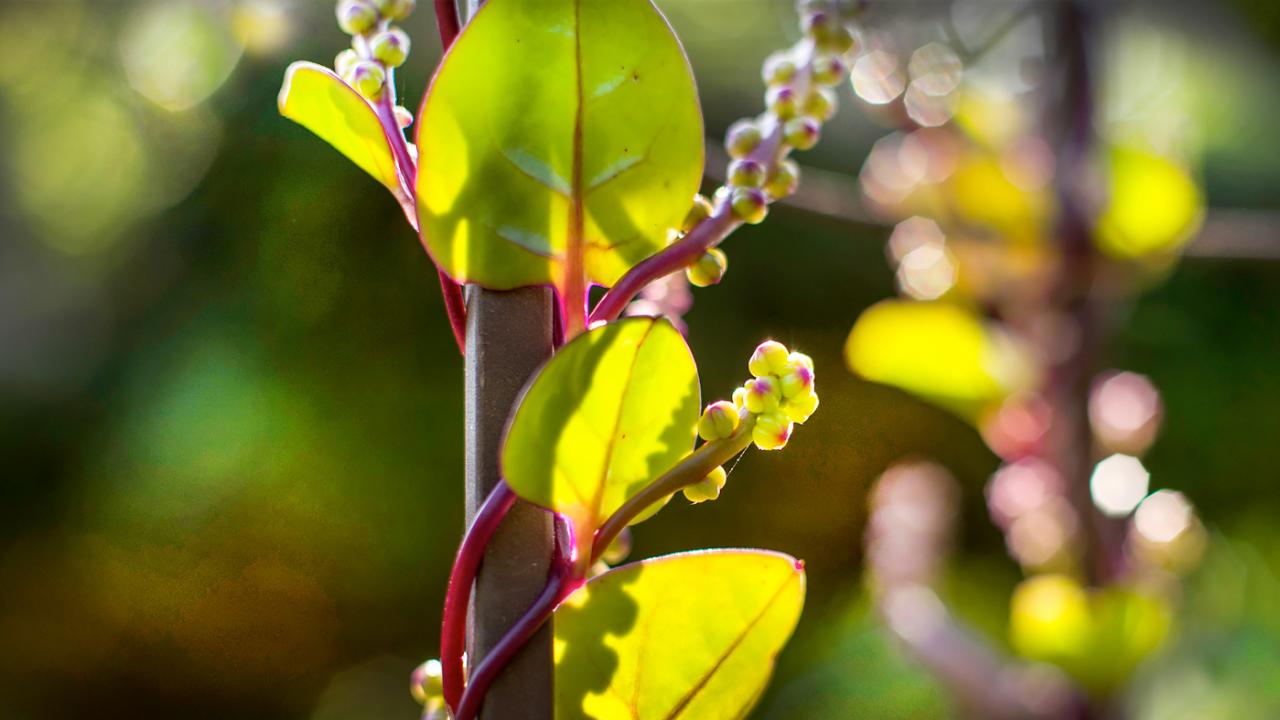

Plants &
Gardening
Garden Stories
Dreaming of spring color
Even as the leaves start to turn in shades of scarlet and gold, we are thinking ahead to nature’s other big show—spring color.
This year, the annual Woman’s Board Fall Bulb Sale is online only. You’ll be able to shop at your leisure for hundreds of varieties of bulbs imported directly from growers in Holland. The members’ presale, with discounted prices, starts September 1; the public sale is September 9 to 25. Order pick-ups are October 9 to 10 at the Chicago Botanic Garden, where you can take in the fall color.
Can’t wait for spring? The sale also offers several fall-blooming bulbs that you can plant immediately for flowering this fall (see the Colchicum selections). Here are some tips and suggestions to help you get started:
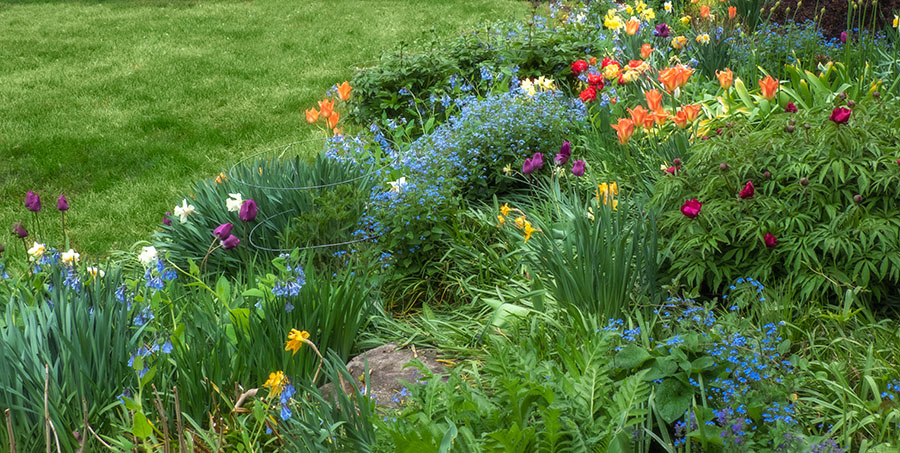
Beautiful mixed bulb border in late April at a Woman’s Board member’s home garden. The bulbs are planted between established shrubs, perennials, and trees, and are selected so that something is in bloom all spring.
Helen Bartlett, horticulturist
One of my favorite combinations is an April bloomer, Narcissus 'Jet Fire' (yellow with orange cup) and Muscari armeniacum (purple grape hyacinth).
Eranthis hyemalis (bright yellow) is one of the earliest blooming bulbs, and it is so small and early blooming that you can plant under trees and next to bushes and perennials without disturbing the light they will need to grow. I also like to plant Eranthis with daffodils and narcissus under a pine tree. It is a good source of food for early pollinators.
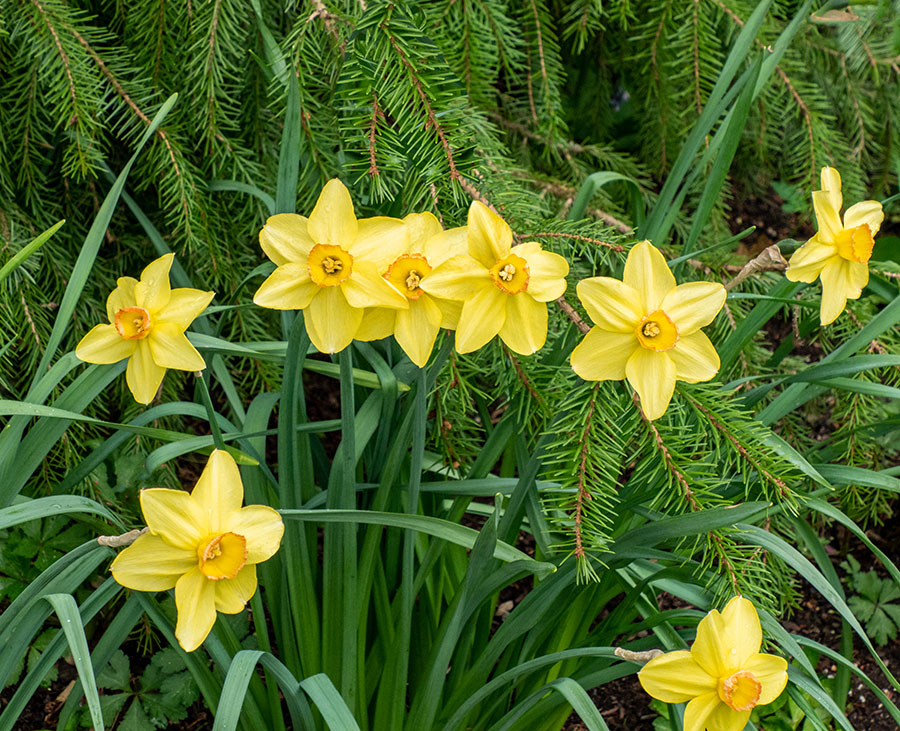
Narcissus blooming under a pine tree
I plant tall, later-spring blooming alliums (purple and white) intermixed with perennials. They will be tall enough to rise above and add dimension to your plantings. I have planted Allium ‘Miami’ with pennisetum (fountain grass) on Evening Island. The pennisetum provides a beautiful green background for the purple Allium 'Miami'.
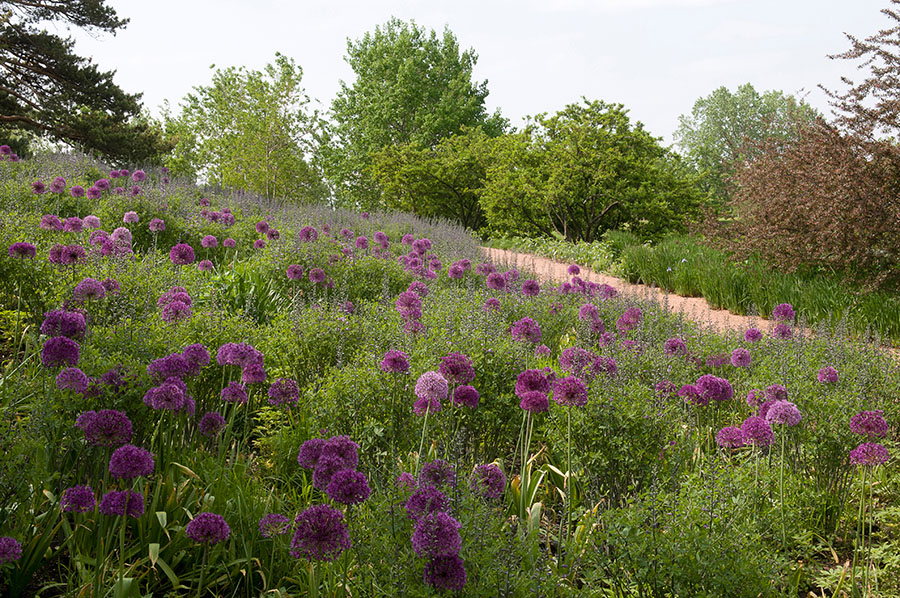
Allium 'Miami' on Evening Island
Pro tip: I am a big promoter of planting crocus bulbs in your lawn. They provide early spring color, and the lawn is harder for squirrels to dig up than your mulched beds. The only drawback is that you will want to put off your first mow until the crocus leaves have begun to turn yellow—not a bad trade for a bit of color in the winter-starved lawn.
Pro tip: Don't forget to take pictures or draw a map when your bulbs are in bloom. This will help you the next fall when you are planning to add to your bulb garden.
Sandy Campbell, Woman’s Board President and Master Gardener
I look at spaces in my garden beds as rooms and plant tulips that complement the decor in the room space—in this case, my front door and porch where I picked pink from the pillows. Each room has a different but complementary color scheme and bulbs. In one of my back beds, I planted the same pink tulip but added yellow, orange, and a multicolor pink/orange/yellow bulb, allowing me to extend those colors to other beds. I also try to plant bulbs in areas where I have landscape lights, as bulbs can be showcased even at night to provide beauty to your yard.
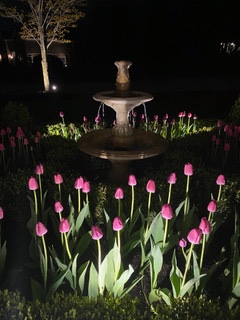
Tulips are showcased at night with landscape lighting.
Susan Green, Woman’s Board member and former Bulb Sale Chair
We are often asked about planting bulbs in containers for spring bloom. Keep in mind that bulbs in outdoor containers require a little extra TLC in the Chicago winters because of our freeze-and- thaw cycles.
Planting bulbs in containers:
- Materials needed: container with drainage holes, potting soil, and bulbs. The size of your container determines the amount and size of bulbs you will need.
- Bulbs need a cold period in order to bloom. You can store them in a cold space, such as a detached garage.
- Choose bulbs with a staggered bloom time or choose only one variety. Plant in late October or early November, water well, and drain.
- Plant bulbs at different depths. Plant larger bulbs deeper than smaller bulbs. Each layer of bulbs needs a layer of soil before the next layer of bulbs. Top layer will be soil. Leave space at the top to allow for watering.
- Before the first frost, put your container in a plastic bag, loosely covering the pot, and insulate it with newspaper and keep it in the garage. Check periodically to water. Don’t over water.
Bulbs that are good for containers include:
- Allium
- Crocus
- Fritillaria
- Hyacinth
- Iris reticulata
- Muscari
- Narcissus
- Scilla
- Tulipa
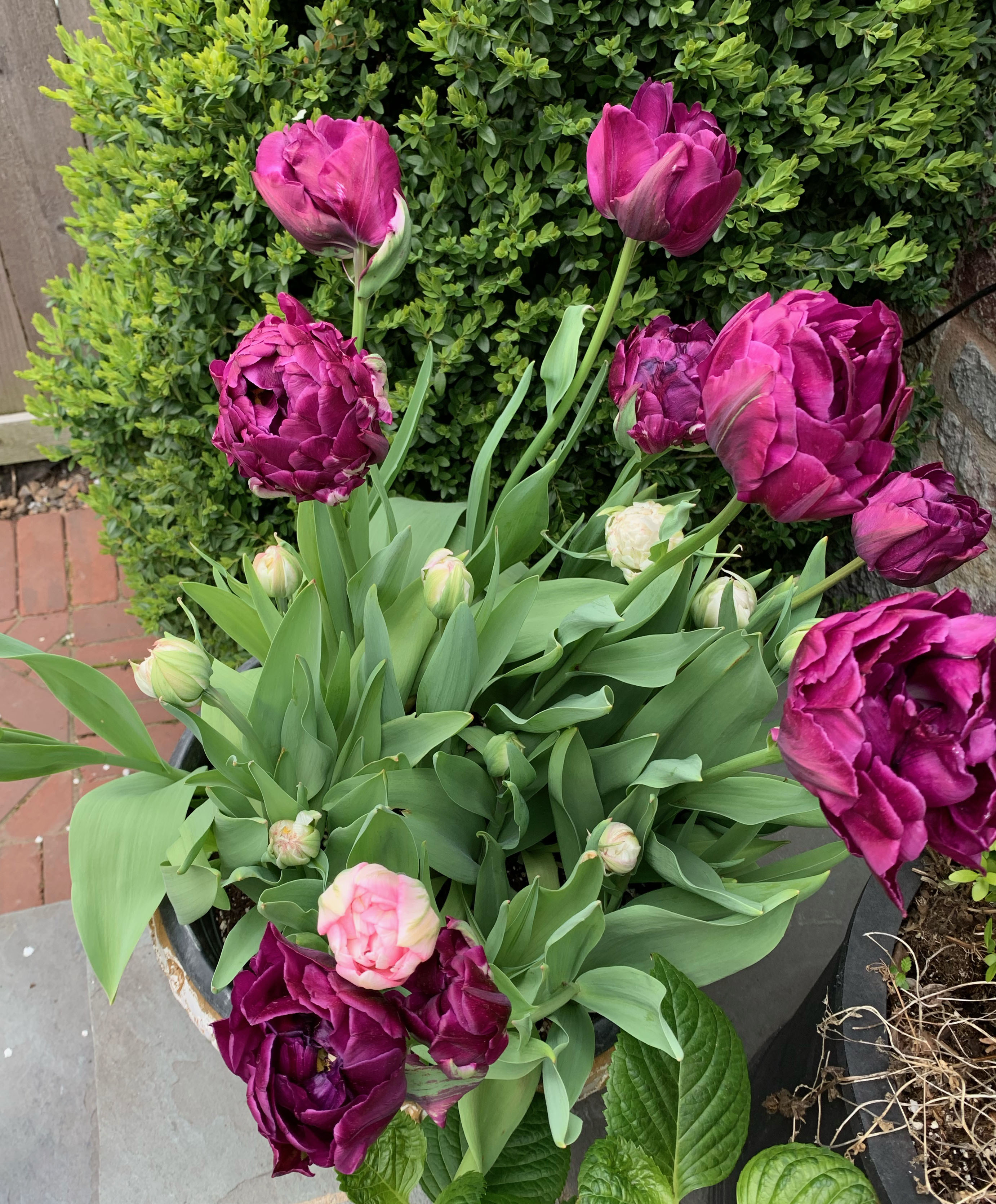
This container features a blend of tulips from one of last year’s bulb sale offerings. The bulbs were split between two containers and were overwintered in an unheated garage.
Joani Lowry, Woman’s Board member and professional gardener
It’s great to combine a wide selection of bulbs mixed with perennials and other plantings. In addition to their welcome beauty and color, flowering bulbs offer an important early food source for pollinators.
Pro tip: When I am planting groups of bulbs, I like to envision bouquets of blooms in the spring. Depending on the size of the bulb, I will dig one large hole approximately 4 to 6 inches deep and 8 to 10 inches wide, and plant a mix of bulbs in each hole. For instance, a combination I love is three varieties of Muscari: ‘Valerie Finis’, ‘Julia’, and ‘Helena’ planted with Narcissus ‘Baby Moon’. For this combination I might dig a group of five holes and, in each hole, plant five ‘Baby Moon’ and five of the mixed Muscari bulbs.
Other favorite bulbs and combinations include the following:
My favorite allium is Allium schuberti, which I like to plant behind perennial lavender plants. I typically dig one hole and plant three of these bulbs per hole. This allium has a huge bloom that puts on a great display. Like all allium, the schuberti is pest resistant. I also like to plant taller allium bulbs among perennial grasses.
Narcissus ‘Cha Cha’ looks great toward the front of a garden bed with Puschkinia scilloides or libanotica alba planted right in front of it. This makes a lovely spring bouquet.
Tulipa ‘Shogun’ and Tulipa ‘Salmon Gem’ are two small species tulip varieties that look stunning planted together. Depending on the number of bulbs in a bag, I might dig several holes and place five of each bulb in a hole.
For Triumph tulips, I love Tulipa ‘Gavota’ (a maroon yellow) with Tulipa ‘Apricot Fox’. These will bloom in mid-to late spring.
Tulip Greigii ‘Pink Dwarf’ with Tulip ‘Calypso’ (salmon)
Pro tip: I encourage beginner gardeners to try out some of our blend mixes available for Tulip Blends, Allium Mix, three different Narcissus blends, and a Fritillaria meleagris mix (another of my favorite bulbs). These collections take the guesswork out of bulb selection. Simply choose a color scheme that appeals to you. The mixes of bulbs are selected by our growers’ experts to have a long succession of bloom times and complementary flower colors and shapes.
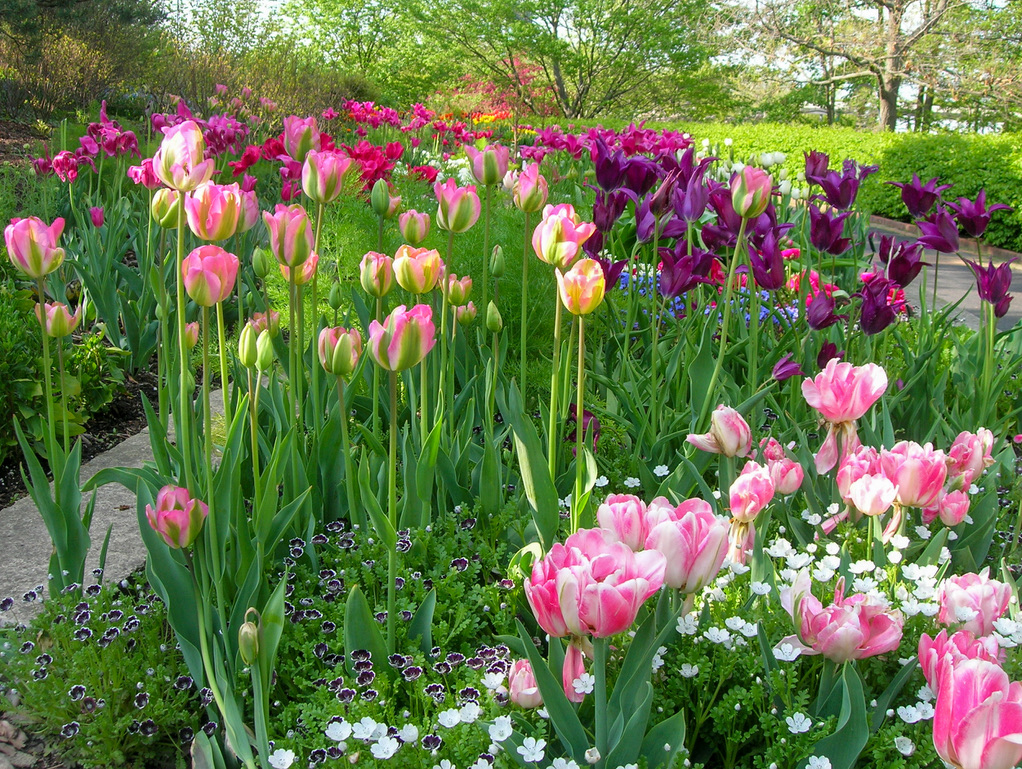
Here’s an example of a Tulip Mix from prior sales. The varieties change slightly each year. Select a blend with colors that appeal to you.
Pro tip: I treat many tulips as annuals and pull them out after blooming. I reserve a “corner of color” to plant new tulip mixes and combinations each year.
Pro tip: I throw in a handful of Muscari bulbs toward the top of the same hole with tulips, narcissus, and other bulbs. The Muscari bulbs go dormant after blooming, but the foliage reappears in the fall, acting as a marker to indicate where the group of bulbs is and allowing you to plant additional bulbs without disturbing your existing ones.
Jill Selinger, adult education manager at the Garden
In general, I like to pick out early, mid-, and late-blooming tulips of a related hue and plant them together to enjoy an extended bloom time.
Here are some of my favorite combinations:
Iris reticulata (try Iris reticulata ‘Harmony’ or ‘Purple Hill’) planted with Tulipa ‘Princess Irene’ makes a pretty and fresh display.
I also love planting North American native Camassia bulbs among clumps of ornamental grasses. (Try Camassia ‘Blue Melody’ or Camassia quamash).
Another favorite is the complementary look of Tulipa tarda interplanted with Scilla luciliae.
Pro tip: Anywhere you have clumps of daylilies, plant narcissus bulbs among them. This is a classic combination. The bulbs will bloom first, and their dying foliage will be covered by the emerging daylily foliage.
Boyce Tankersley, director of living plant documentation at the Garden
A year of blooms: In my small home garden (a typical suburban 1/8th acre) and here at the Chicago Botanic Garden, I really enjoy a progression of spring bulbs, starting with Galanthus nivalis. While the snowdrops are still in flower the tommy crocus, Corydalis, and Muscari azureum appear under the Japanese maples and in the small rock garden. Iris reticulata add to the spring bulb symphony along sidewalks, in the rock garden and under the deciduous trees, followed shortly by the later flowering snowdrops (Galanthus nivalis ‘Flore Plena’, for example). By this time the species tulips are showing color, you’ll see the earliest of the narcissus cultivars accompanied by the later flowering Muscari armeniacum. As the earliest bulbs begin to set seed the Phlox subulata (moss phlox) kicks into high gear, followed shortly by the midseason narcissus and the Darwin Hybrid tulips. Late season narcissus are a nice complement to tree peonies. As these peak, the fragrant late season Narcissus triandus pick up the notes accompanied by the fragrant Narcissus jonquilla (try Narcissus 'Kokopelli'). Allium moly ‘Jeannine’ appears about this time, along with the tall single late-flowering tulips, complemented by tall bearded iris. Camassia fill in the wetter spots in my garden, as the peonies begin to flower. If the rabbits/chipmunks/squirrels haven’t been too hungry the earlier flowering Martagon lilies bring the garden up to mid-summer, accompanied by the roses and the Crinum lilies. Lilies of all sorts carry the show, and at both my home and at the Garden, the dahlias often take pride of show this time of year, continuing up to the first hard frost. The Lycoris (Surprise Lilies) start to appear in August in the rock garden, as well as the mixed perennial/shrub tree cottage garden. As the last of the Lycoris set seed as the earliest of the fall-blooming colchicum start to appear (try Colchicum 'Waterlily' or Colchicum specious 'The Giant') and the colchicum season continues well into mid-October.
